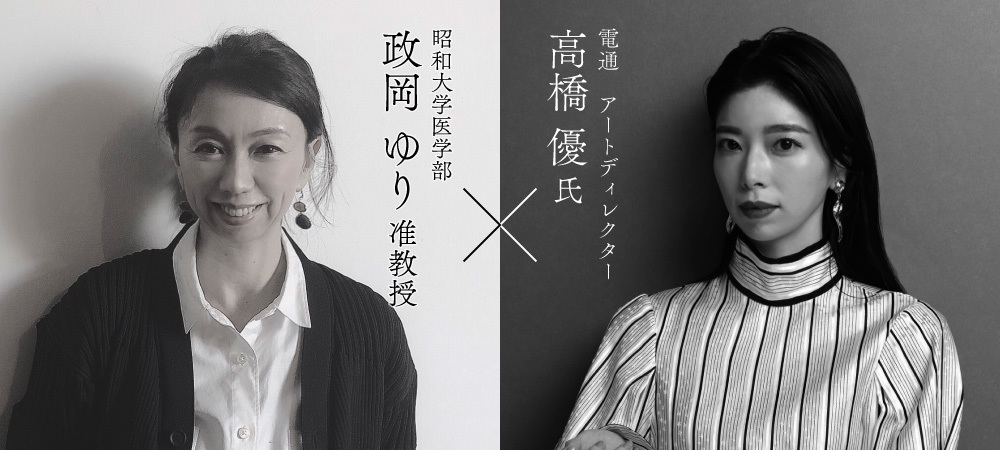"ART for Medical" is a medical × art project developed through research collaboration between the Department of Physiological Regulation at Showa University School of Medicine and Dentsu Inc. It aims to use the power of art to make healthcare more accessible and enjoyable, thereby improving QOL (Quality of Life).
An estimated 5.3 million people in Japan live with chronic obstructive pulmonary disease (COPD). Its main symptoms include shortness of breath, difficulty breathing, and a feeling of breathlessness. Even people without respiratory diseases have increasingly reported feeling breathless in recent years. With the pandemic increasing mask-wearing, more people are unconsciously taking shallow breaths or experiencing mental stress negatively affecting their breathing.
As our first challenge, we present "Seeing Breath," a media art exhibition (*) that visualizes breathing to help regulate it.
This time, we welcomed Associate Professor Yuri Masaoka from Showa University School of Medicine, who served as a partner supervising this exhibition from medical and psychophysiological perspectives. We also spoke with Dentsu Inc.'s Yu Takahashi about the potential of Medical × Art from an academic viewpoint.
※=Media Art
Artworks utilizing digital technology
【"Seeing Breath Exhibition" Overview】
<Held at Showa University Kamijo Memorial Museum until March 22, 2022>
A media art exhibition themed around "Visual Breathing Rehabilitation," which visualizes unconscious breathing to draw attention to it and help regulate breathing.
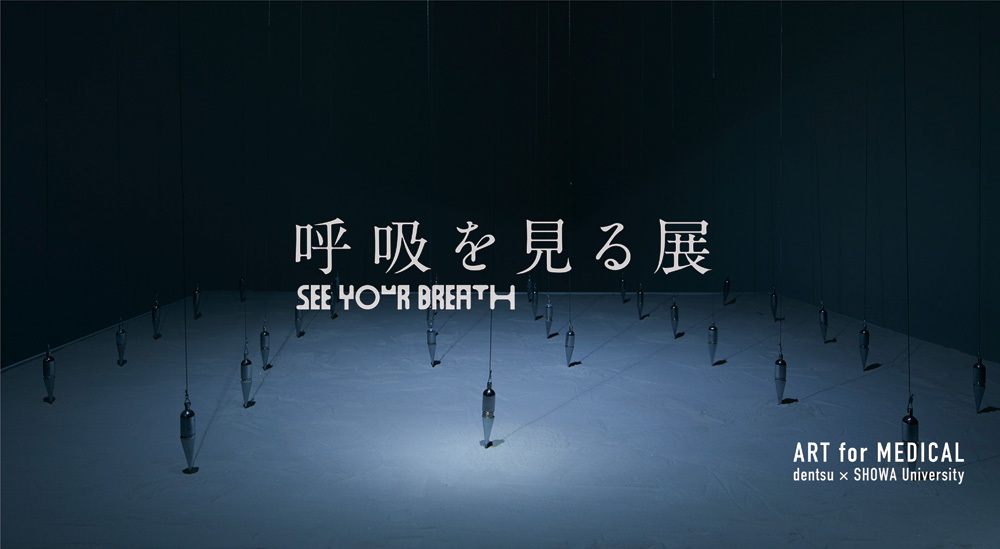
Organized by: Department of Physiological Regulation, Division of Physiology, Showa University School of Medicine / Yuri Masaoka & Sponsored by: Showa University Kamijo Memorial Museum Emiko Oguchi / Yuichi Yamamura Showa University School of Medicine
Department of Physiology, Division of Physiological Regulation, Supervision: Masahiko Izumisaki / Motoyasu Honma / Shotaro Kamijo Creative Director: Kentaro Suda Art Director: Yu Takahashi
Creative Technologist: Momoka Nakayama Artwork Provided "Iki-Utsushi": Yukiya Yamane/Hanako Yano Graphic Production: Mao Fujimoto/Miyuki Imai/Ayano Ito (ADBRAIN) Space Design Production: Hitomi Nakazawa (CBK)
Work ① "SEE YOUR BREATH"
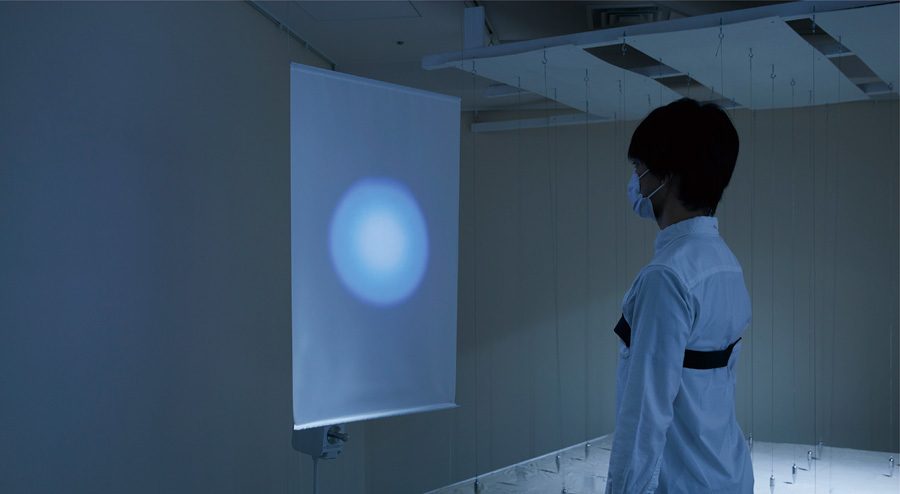
A 2D work where circles projected onto the screen synchronize with the viewer's breathing.
Work ② "SEE MEDICINE"
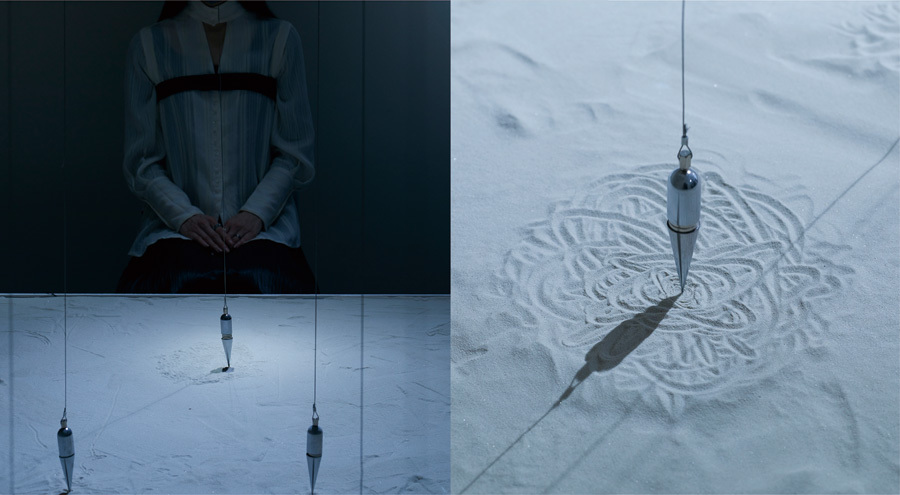
A 3D work where a suspended pendulum moves in sync with your breath, creating sand art through its trajectory.
Work ③ "Life-Transmission"

A work where paintings expressing joy, anger, sorrow, and pleasure synchronize with your own breathing. You can physically experience how the emotions conveyed by the paintings' expressions spread through your breath.
Work ④ "SEE YOUR BREATH"
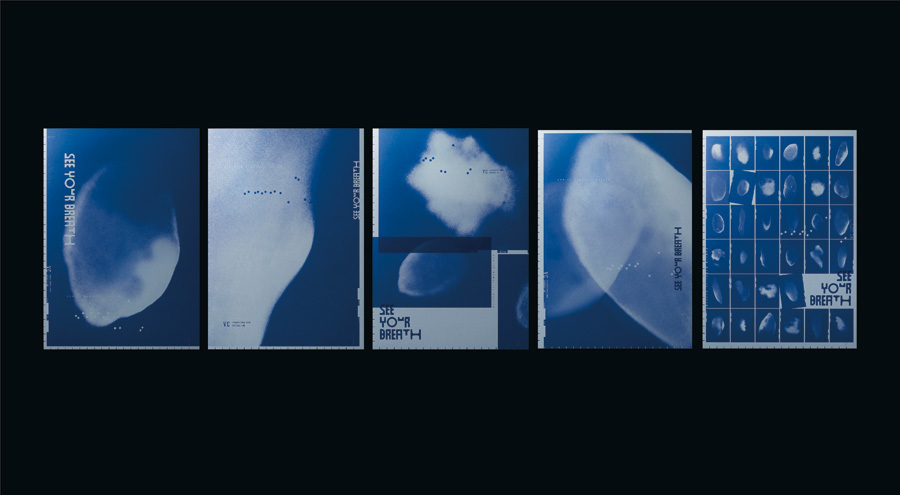
Graphics conveying the diversity of breathing. Real people's breath is captured and rendered using the blueprint technique to express humidity and vividness.
The function of "breathing" as a potential intersection of medicine and art
Takahashi: The background for launching ART for Medical was the belief that if medical institutions became places people wanted to visit—enjoyable extensions of daily life—rather than obligatory destinations only after falling ill, people would become more conscious of their health and better maintain their quality of life. As an art director, I felt there must be something I could do to contribute to that.

While various initiatives exist globally, the Canadian Medical Association's 2018 move—the world's first to "prescribe" museum visits as therapy—was impactful in demonstrating art's integration into healthcare.
This time, with "suffocation = the pain of living" as our backdrop, we created our output based on foundational research from the Showa University School of Medicine's Laboratory of Physiological Regulation, receiving extensive advice from the professor. First, could you tell us about "breathing"?
Masaoka: I work in a basic research lab focusing on physiology at Showa University School of Medicine, primarily studying human respiration. While respiration is first thought of as the vital physiological function of taking in oxygen and expelling carbon dioxide, it also has aspects that change with emotion and conscious intent. Breathing can be seen as a tool for expressing emotion and will, and I've long felt its characteristics make it a potential point of intersection between medicine and art.
For instance, music has a profound connection with breathing. In choral singing or orchestral performances, "synchronizing breath" enhances empathy and creates a sense of unity. Furthermore, in Noh, a traditional Japanese performing art, it has been clearly demonstrated that the subtle movements of the Shite's heart are linked to the representation of their breath. Breathing is also inseparable from theatrical performances involving physical expression and martial arts. Breathing has long been deeply connected to art and culture, possessing functions that enable people to live richly.
Now, the COVID-19 pandemic threatens even the very act of breathing for survival. SpO2 (arterial blood oxygen saturation) serves as an indicator to monitor oxygen levels within the body. When SpO2 drops, we feel shortness of breath as a warning signal from the body. The problem arises when we experience this shortness of breath even though our oxygen levels are normal. This is likely because emotions like anxiety and fear intensify the sensation of breathlessness. Furthermore, many people are breathing shallowly and rapidly due to the physical and psychological stress caused by masks. Consequently, more people are experiencing a relative sense of breathlessness.
Takahashi: "Demon Slayer" also features the Full Concentration Breathing Technique. Traditionally, Japanese people have recognized the deep connection between breathing and emotions, as seen in practices like sitting in zazen at temples to focus on breathing and unify the mind. In situations like the present, I feel it's crucial for more people to consciously focus on their breathing to maintain both physical and mental health.
Breathing is something we can consciously control.
Masaoka: Beyond being a "basic physiological function," breathing can be divided into three types: "emotional breathing," and "breathing that can be voluntarily changed by will." The type that changes due to anxiety or fear, as mentioned earlier, is "emotional breathing."
Factors causing breathlessness include physical ones like respiratory diseases, or even in healthy people, insufficient oxygen during exercise, tightness in the respiratory muscles, or poor posture preventing deep inhalation. Then, as mentioned earlier, mental factors like negative emotions such as anxiety can cause shallow breathing, triggering breathlessness. Because various elements are intertwined, I often feel that medical approaches alone are insufficient for improvement.
Takahashi: So when oxygen levels are normal but breathlessness is felt, addressing it requires rehabilitation using both physical and psychological approaches. I heard your research showed experimental results indicating that consciously controlling breathing can reduce anxiety even under stressful conditions.
Masaoka: That's correct. Taking deep, slow breaths lowers anxiety. Animals cannot consciously alter their breathing, but humans can control it through willpower. That's where the salvation lies. When you feel tense and your heart rate rises, you naturally take a deep breath to calm yourself, don't you?
The reason I research "emotional breathing" is that I believe ideal rehabilitation to eliminate breathlessness could be achieved not only through such voluntary breath control, but also by learning to naturally alter breathing patterns. Breathing changes simultaneously with emotional movements. If we can move emotions through artistic expression, we can naturally induce changes in breathing.
Takahashi: In medical settings, methods to alleviate respiratory distress include oxygen administration, medication, and exercise therapy. It's fascinating that by approaching the aspects medicine can't resolve through the connection between body and mind, we can naturally change breathing patterns.
Masaoka: This research is being applied in our current exhibition. Hearing visitors say, "I realized my breathing had changed naturally," gives us a tangible sense of having cleared the first hurdle.
The Potential of Visual-Based Breathing Rehabilitation
Masaoka: The exhibition featured a piece called "Breath-Reflection," right? The portrait displayed in front of you breathes in sync with your own breathing. This work clearly expresses the emotional resonance that arises through shared breathing.

For example, when you're feeling sad and see Picasso's "Weeping Woman" breathing in the same way as you, it evokes a feeling that she's sympathizing with you.
Furthermore, visualizing the normally invisible act of breathing within a painting creates a desire to intentionally alter the artwork through breathing. When you let "Weeping Woman" breathe slowly, you get the illusion that her sadness somehow diminishes. Your own emotional sadness also lessens. This synchronized breathing, called emotional contagion, can foster empathy for another's emotions. Just as seeing someone struggling to breathe makes your own breathing quicken and feel uncomfortable.
Takahashi: I experienced this myself during the experimental phase. When the painting's figure moved in sync with my own breathing, I felt my emotions transferred onto the painting. It also made me want to consciously control my breathing. This approach involves using visual stimuli to alter breathing, and by regulating breathing, changing emotions.
Masaoka: The strength lies in the fact that breathing can be visualized. Changes in heart rate aren't visible to the eye. Changes in breathing connect to emotions and may even influence behavioral changes.
In yoga and mindfulness, we're often instructed to focus on our breath, but I frequently hear that being told to do so can actually make breathing feel constricted. In the "SEE YOUR BREATH" installation, breathing is visualized through an image of a circle on the screen that expands and contracts. This allows people to observe their own breathing objectively, and some participants reported not feeling the usual sense of breathlessness.
Takahashi: I've sometimes felt that since visual information is so overwhelming and overused in today's world, we should give our eyes a rest. But the significance of how visual art can positively impact mental and physical health is immense. I see great potential in the shift from "visual communication" to "visual action."
Masaoka: Recently, I met someone who visited the exhibition. They said that when exhausted from work, they looked up at the sky and exhaled deeply. They wanted to recreate the shape of their breath, depicted in blueprint, within the blue sky. I thought it was wonderful that the art they saw visually was being recreated in their daily life.
Takahashi: I'm delighted that people are incorporating graphic posters into their daily lives. Each breath creates a unique shape, varying in size and density. Using blueprint paper, which is photosensitive to sunlight, allowed us to better express the slight blur from the breath's movement and the sense of humidity.
If there were medical institutions that prescribed art...
Masaoka: While vision serves as the medium in this exhibition, what's crucial isn't "what you saw" but "how your heart moved." The origin of the word "emotion" is e(outward) + movere(to move), meaning it's what stirs the heart and becomes the driving force of life. I'd like to create works using other senses as media too—not just sight, but hearing, smell, touch, taste. I believe there is always scientific evidence for the effects brought about by emotional movement.
Ideally, I envision hospitals with attached art galleries where staff could suggest to patients feeling breathless or anxious, "Viewing artwork number X helps regulate breathing and reduce anxiety." Providing an environment where one's breathing naturally stabilizes through art would be ideal.
Takahashi: Like this exhibition, I hope we can create spaces positioned between home and hospital, between medical procedures and daily health management—places where individuals can proactively and enjoyably take charge of their own well-being, just before they enter the realm of medical care.





